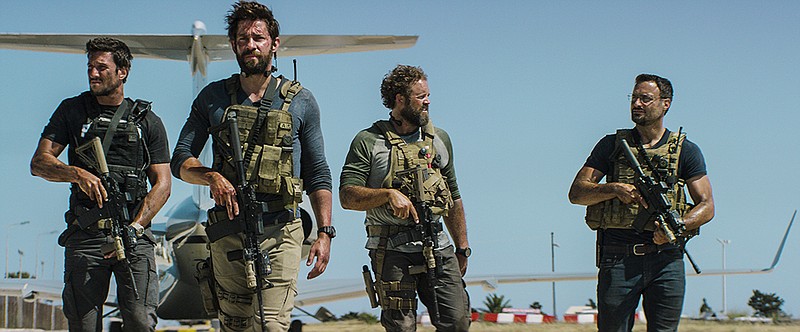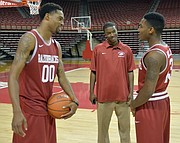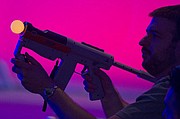WASHINGTON-Michael Bay's new film, "13 Hours: The Secret Soldiers of Benghazi," tells the story of the deadly Sept. 11, 2012, attacks in Libya through the heroics of the private security contractors assigned to protect Americans.
The movie, like the book it is based on, focuses on events in Benghazi during the 13-hour siege, which took place at the lightly guarded U.S. diplomatic mission in Benghazi and a secret CIA "annex" less than a mile away. Four Americans, including U.S. Ambassador Chris Stevens, died in the twin attacks.
The 2 1/2-hour film largely steers clear of politics to emphasize what Bay calls the "great human story" of the half-dozen security contractors who fought through the night and saved dozens of Americans.Still, it makes some controversial assertions, including a cinematic take on a widely debunked claim that a top official issued a "stand down" order, delaying a rescue operation at the diplomatic compound. The movie also depicts repeated requests by Americans on the ground in Benghazi for U.S. military air cover that never came and touches briefly on a dispute over whether the attack was inspired by an anti-Muslim video, as some U.S. officials suggested.
Some of the movie's claims and how they compare with the facts:
"Stand down! Wait for my word. ... You will wait."
The movie shows a CIA station chief identified only as "Bob" telling one of the contractors, Tyrone "Rone" Woods, that he and his team must wait for help from pro-American Libyan forces rather than move out on their own to rescue Stevens and other U.S. officials after they are attacked by Libyan militants. Bob explains that the existence of CIA annex is still secret, and says that by departing the annex, the contractors would be leaving it exposed to enemy assault and placing the lives of more than 30 Americans at risk.
"You're not the first responders. You will wait," Bob says in the movie. Eventually, the contractors leave anyway, about 20 minutes after the assault on the diplomatic mission begins. They are unable to save Stevens or communications officer Sean Smith; both died of smoke inhalation after the mission was set afire.
THE FACTS: A 2014 report by the House Intelligence Committee said it "found no evidence that there was either a stand down order or a denial of available air support" after the State Department compound came under attack. A report by Republicans on the House Armed Services Committee also said no restrictions were placed on a military response.
The "stand down" theory has taken on a life of its own and centers on a Special Operations team that was stopped from flying from the Libyan capital, Tripoli, to Benghazi after the attacks of Sept. 11-12, 2012, had ended. Instead, the team was instructed to help protect and care for those being evacuated from Benghazi and from the U.S. Embassy in Tripoli.The senior military officer who issued the instruction to "remain in place" and the detachment leader who received it said it was the right decision and has been widely mischaracterized. The order was to remain in Tripoli and protect some three dozen embassy personnel rather than fly to Benghazi some 600 miles away after all Americans there would have been evacuated. The medic is credited with saving the life of an evacuee from the attacks.
The CIA base chief, whose name has not been made public, disputes the movie's account. "There never was a stand-down order," he told The Washington Post. "At no time did I ever second-guess that the team would depart."
The author of the book upon which the film is based, Mitchell Zuckoff, told The Associated Press that he based the scene on several firsthand accounts. Zuckoff collaborated on his book, "13 Hours," with some of the surviving security contractors.
"It's not credible what he's claiming," Zuckoff said of the station chief. Zuckoff said he had tried to interview the station chief when writing the book, but his request was denied.
"I called for air support. It never came."
A CIA analyst tells a colleague after the second attack - a military-style assault on the CIA annex - that she asked for military support, but it never came.
"If you don't send air support, Americans are going to die," including her, the analyst says in a phone call with an unidentified person. "I'd settle for a few F-16s," she adds, referring to Air Force jets.
THE FACTS: Former Defense Secretary Leon Panetta and other top officials have said they moved quickly to deploy commando teams from Spain and Central Europe during the chaotic assaults, but the first military unit didn't arrive until 15 hours after the first of two attacks.
"Time, distance, the lack of an adequate warning, events that moved very quickly on the ground prevented a more immediate response," Panetta told Congress in 2013.
A report by the House Armed Services Committee said that U.S. Air Force F-16 fighters stationed at Aviano, Italy, at the time were configured for training flights. None was on combat alert.
At a 2013 hearing, Sen. Kelly Ayotte, R-N.H., pressed Gen. Martin Dempsey, then the chairman of the Joint Chiefs of Staff, on why the F-16s in Aviano weren't sent to Libya. Dempsey said it would have taken up to 20 hours to get the planes ready and on their way, and he added that they would have been the "wrong tool for the job."
Panetta later explained to lawmakers: "You can't willy-nilly send F-16s there and blow the hell out of place. ... You have to have good intelligence."
"I didn't see any protests."
Tyrone Woods, who was one of the four Americans killed in the attacks, says during a lull in the fighting that he had already heard about stories in the U.S. news media that portrayed the attacks as a protest gone awry. He says he didn't see any protesters in Benghazi.
THE FACTS: Protesters angry about an anti-Muslim video had stormed the U.S. Embassy in Cairo earlier that day, clambering over the walls and setting flags on fire, attracting international attention. Protests soon spread throughout the region.
Some Obama administration officials, including former Secretary of State Hillary Clinton, have suggested a link between the attack and the anti-Muslim video. In a statement issued after the first attack, Clinton said, "Some have sought to justify this vicious behavior as a response to inflammatory material on the Internet." Republicans have accused Clinton of trying to mislead the country about the attacks, especially since she told her daughter, Chelsea, in an email that night that two State Department officers were killed in Benghazi by an al-Qaida-like group.
Clinton, now a Democratic candidate for president, is not mentioned in the movie. She told the House Benghazicommittee last October that "there were probably a number of different motivations" for the attacks. "None of us can speak to the individual motivations of those terrorists who overran our compound and who attacked our CIA annex," she said.
The House Intelligence report said there was "a stream of contradictory and conflicting intelligence that came in after the attacks," but said intelligence "ultimately proved ... there was no protest" in Benghazi that day.
Poor security at the diplomatic compound
The movie repeatedly makes the point that the diplomatic post where Stevens and Smith were killed was poorly protected, and that State Department security agents knew they could not defend it from a well-armed attack.
THE FACTS: The House Intelligence report and other inquiries, including one by an independent panel appointed by the State Department, agree. Numerous reports have found that requests for security improvements at the mission were not acted upon in Washington.
An accountability review board appointed by the State Department concluded that systemic management and leadership failures at the agency led to "grossly" inadequate security at the Benghazi mission.



